Abstract
Samples from a sow serum bank representative of the pig population of Great Britain collected during 1991-2, were examined for antibodies to influenza A, B and C viruses, using viruses which had been isolated from a variety of hosts. For influenza A viruses there was evidence of the continued circulation of classical swine H1N1 virus (26%) seroprevalence), and human H3N2 viruses (39%) which are antigenically most closely-related to A/Port Chalmers/1/73 virus. In addition antibodies were detected to A/swine/England/201635/92 (8%), a strain of H3N2 virus which appears to have arisen by antigenic drift from conventional H3N2 swine strains. Specific antibodies (2%) were detected to an H1N1 virus (A/swine/England/195852/92) related most closely to avian H1N1 strains. In tests with human H1N1 and H3N2 viruses, excluding isolates from pigs, the highest seroprevalence was detected to the prevailing strains from the human population. Serological tests with avian H4 and H10, human H2, equine 1 and 2 influenza A viruses were all negative. Seven pigs seropositive by haemagglutination-inhibition, virus neutralization and immunoblotting assays for antibody to influenza B virus, were randomly distributed geographically suggesting that influenza B viruses may be transmitted to pigs but fail to spread. The seroprevalence to influenza C viruses was 9.9% indicating that these viruses are widespread in pigs. These results provide further evidence that the pig can be infected by a number of influenza viruses, some of which may have significance in the epidemiology of human influenza.
Full text
PDF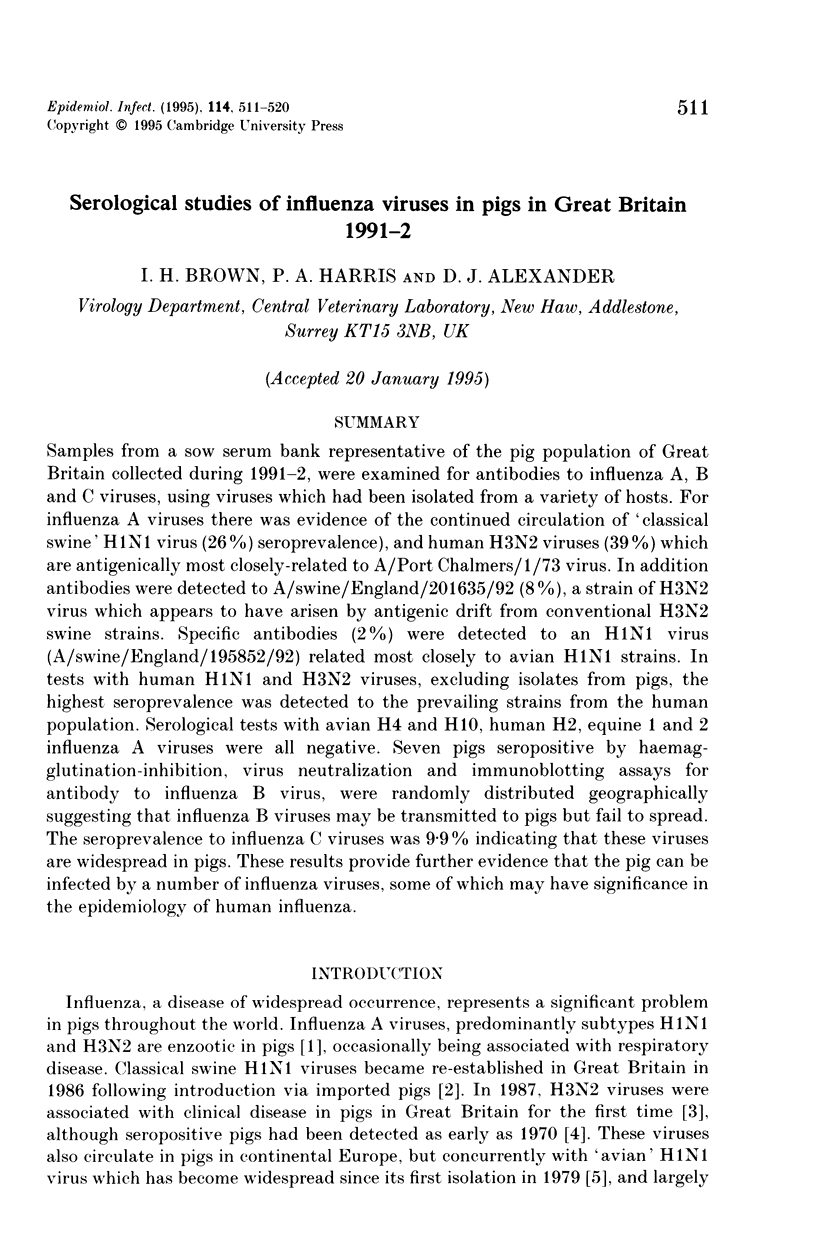
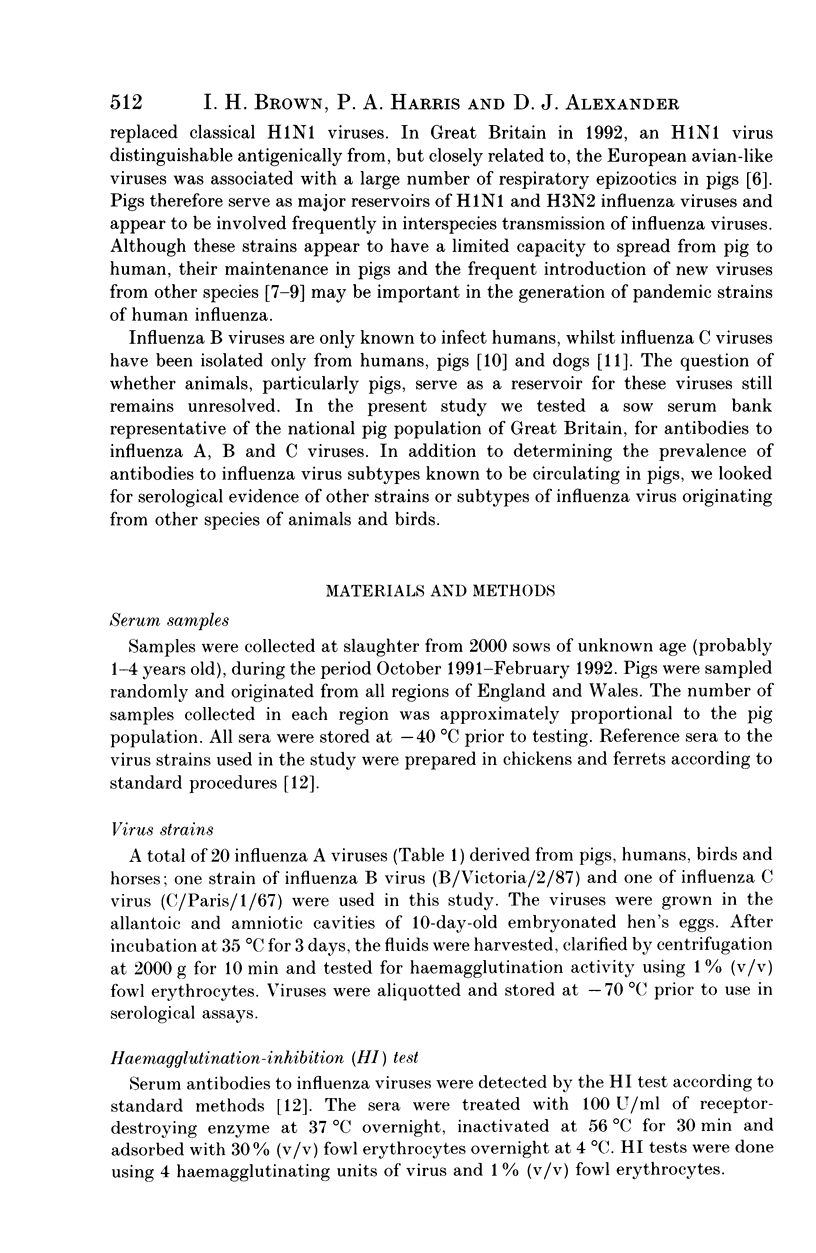
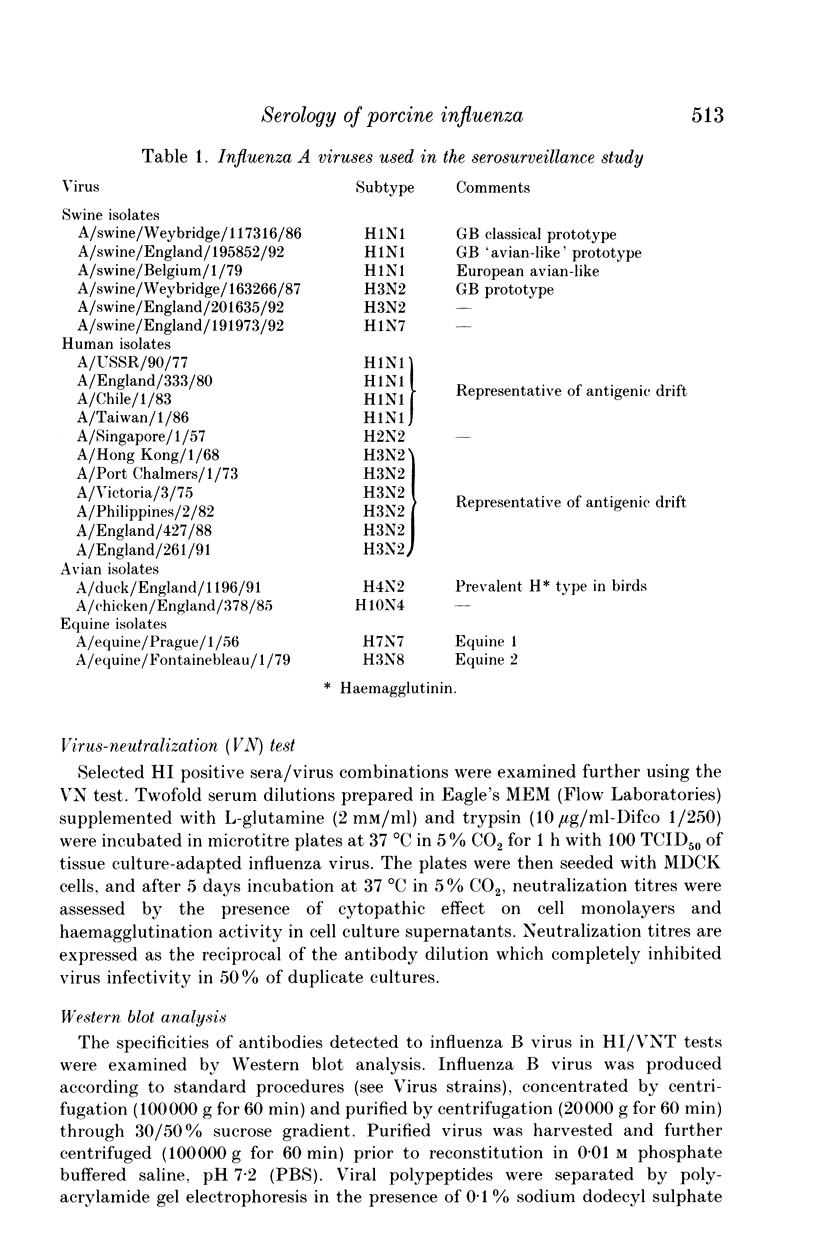
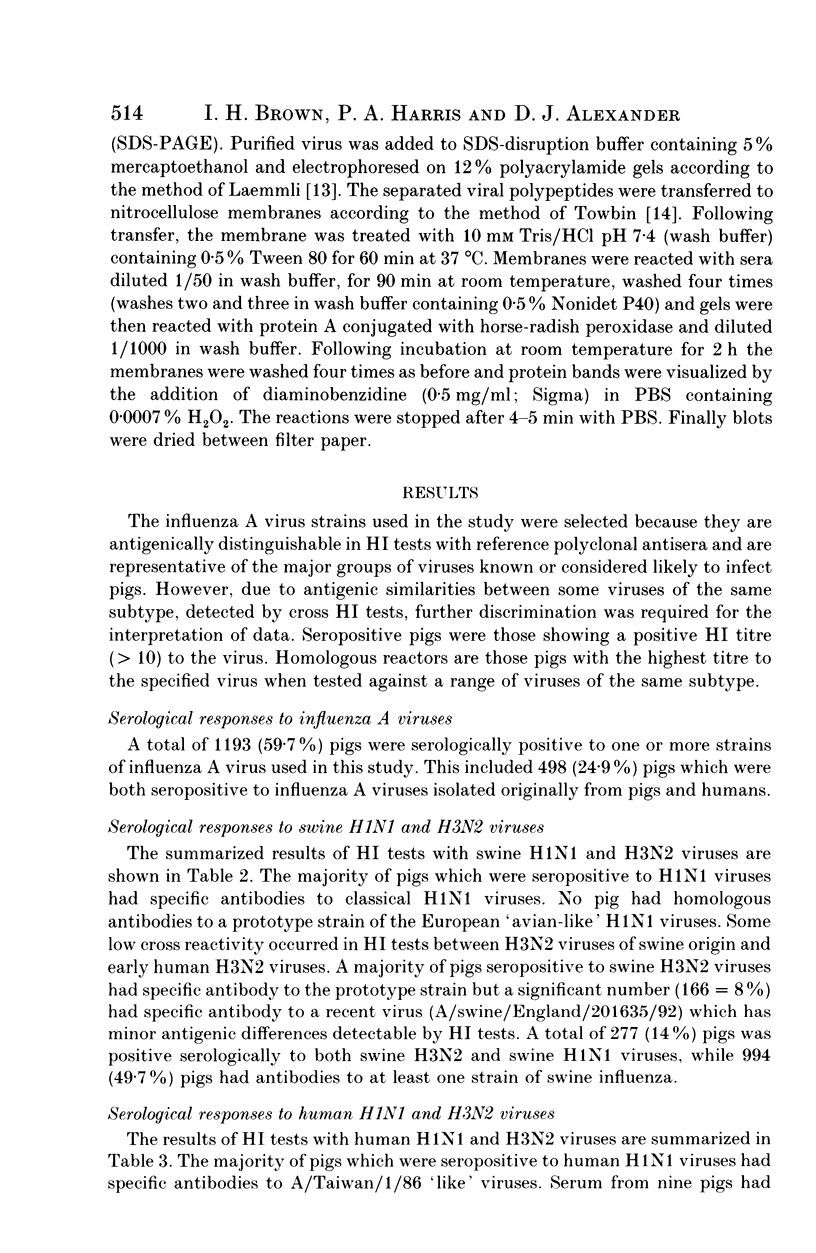
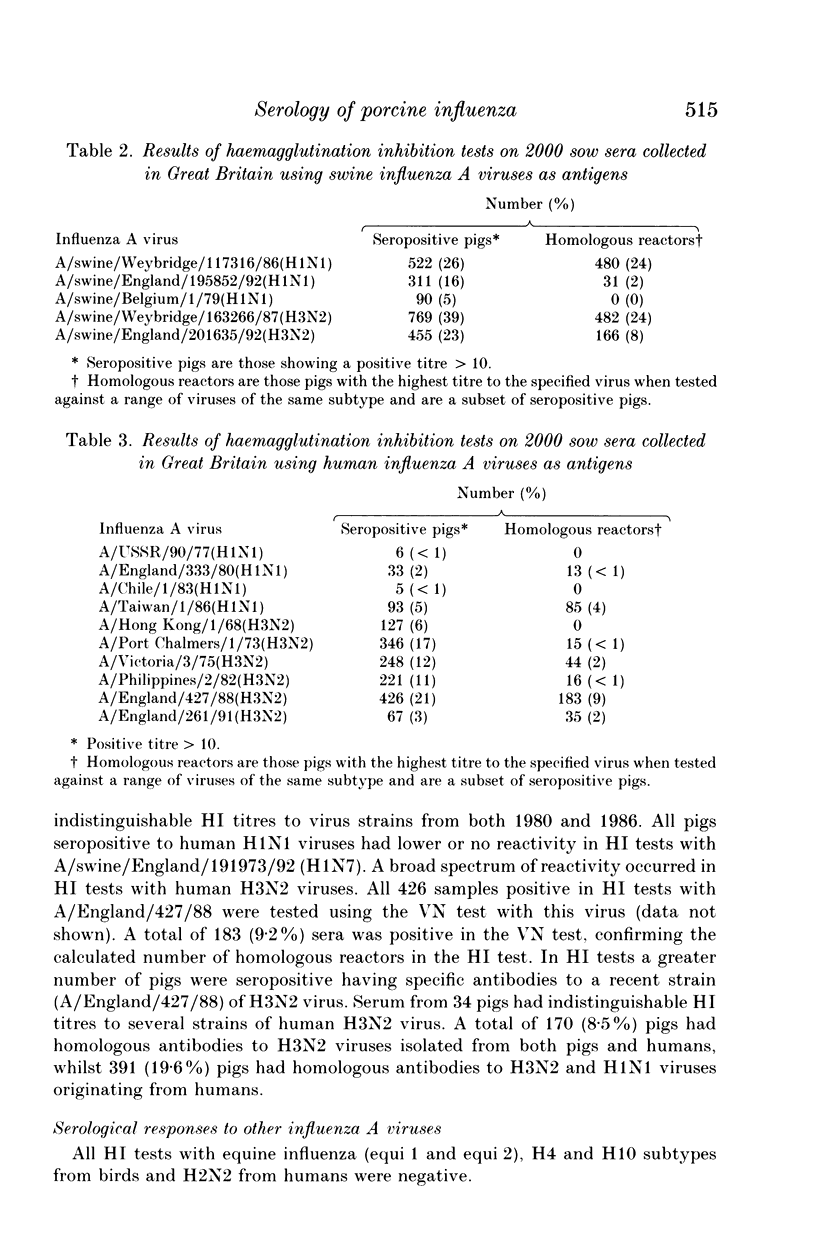
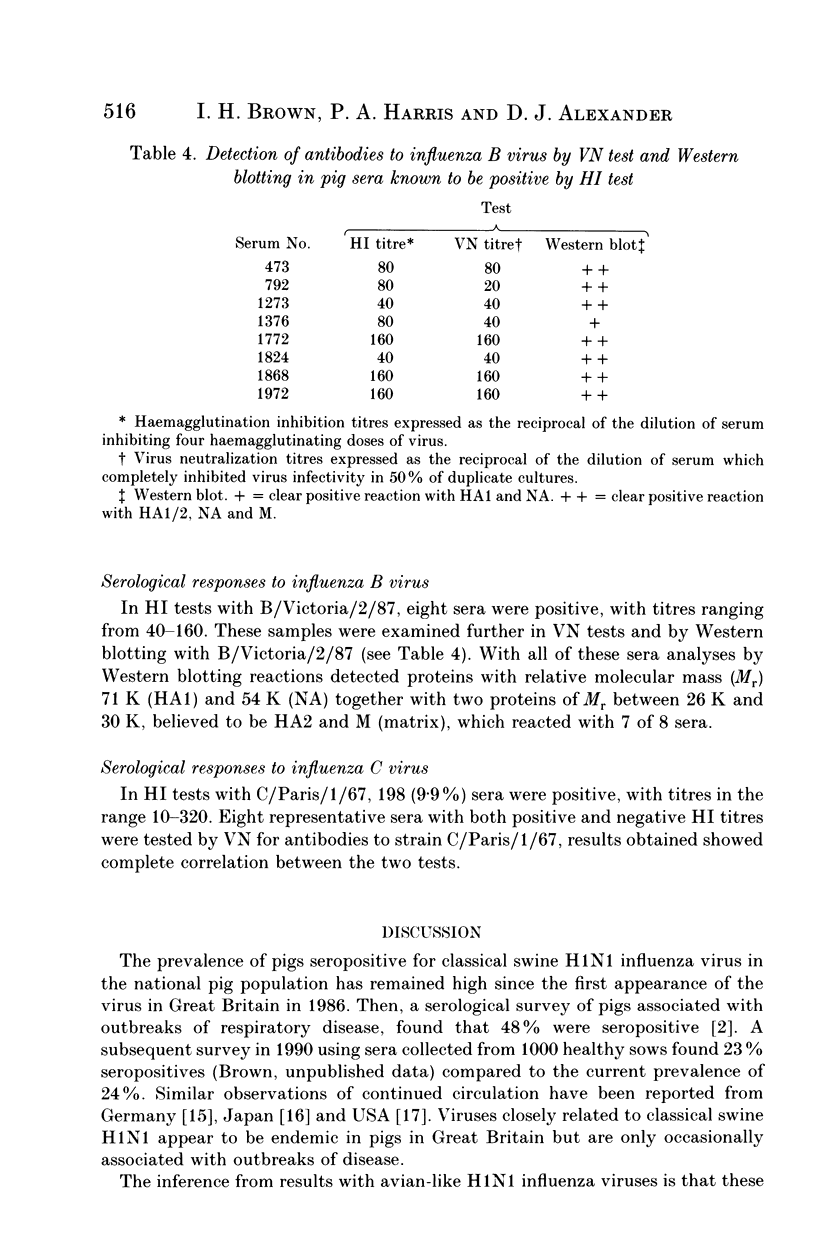
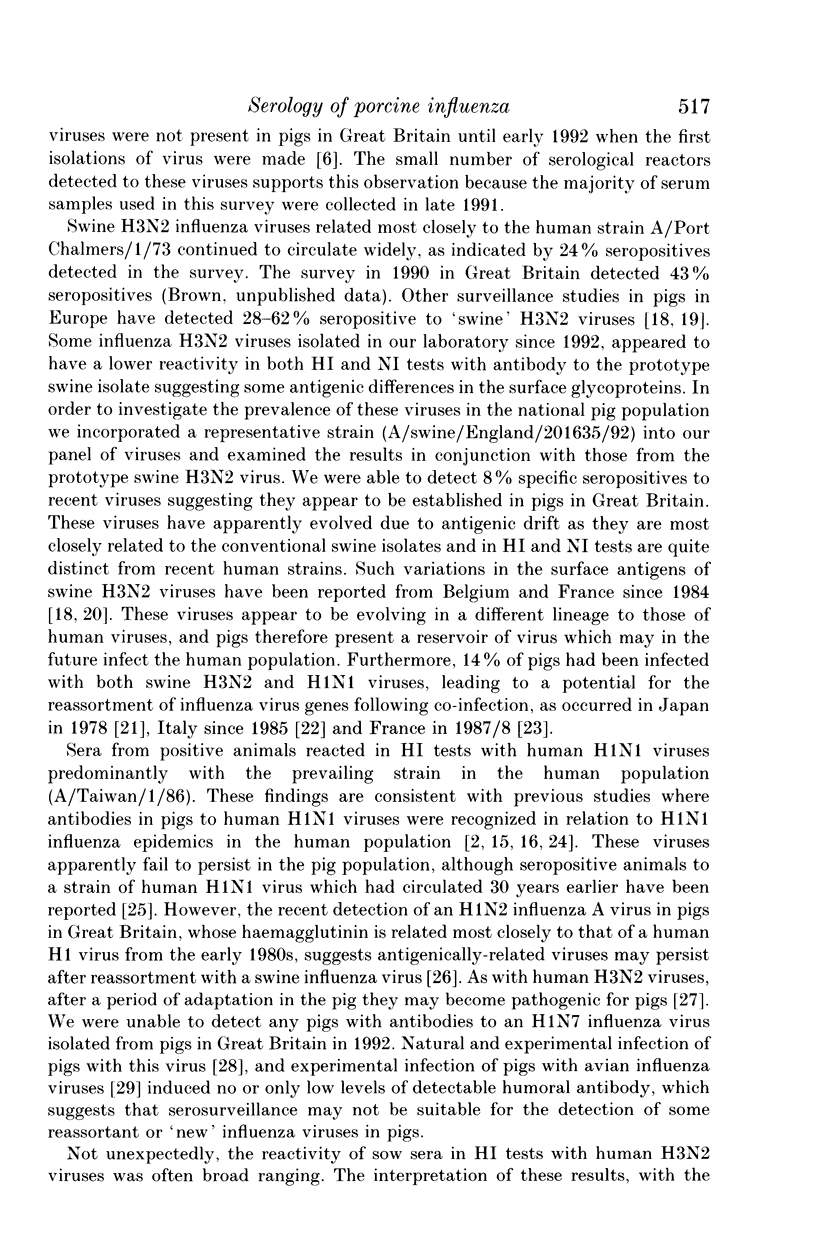
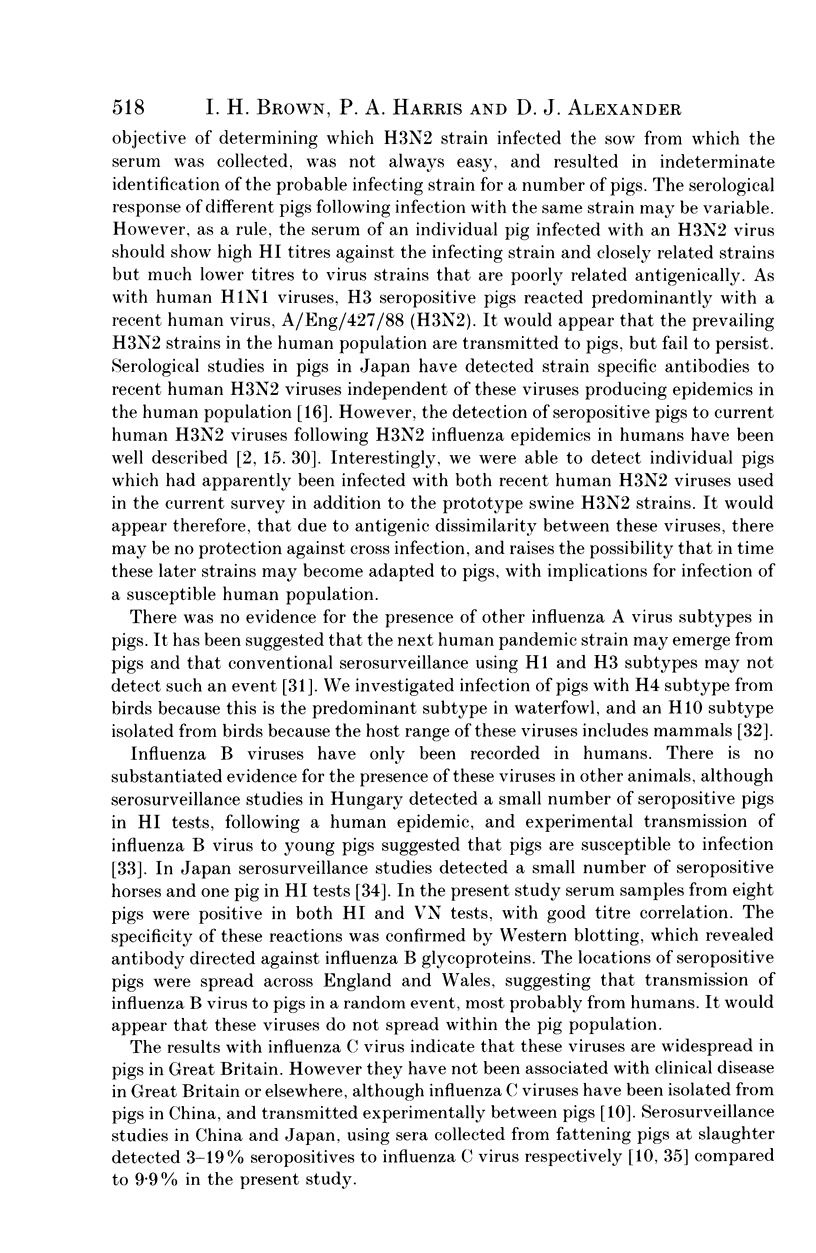
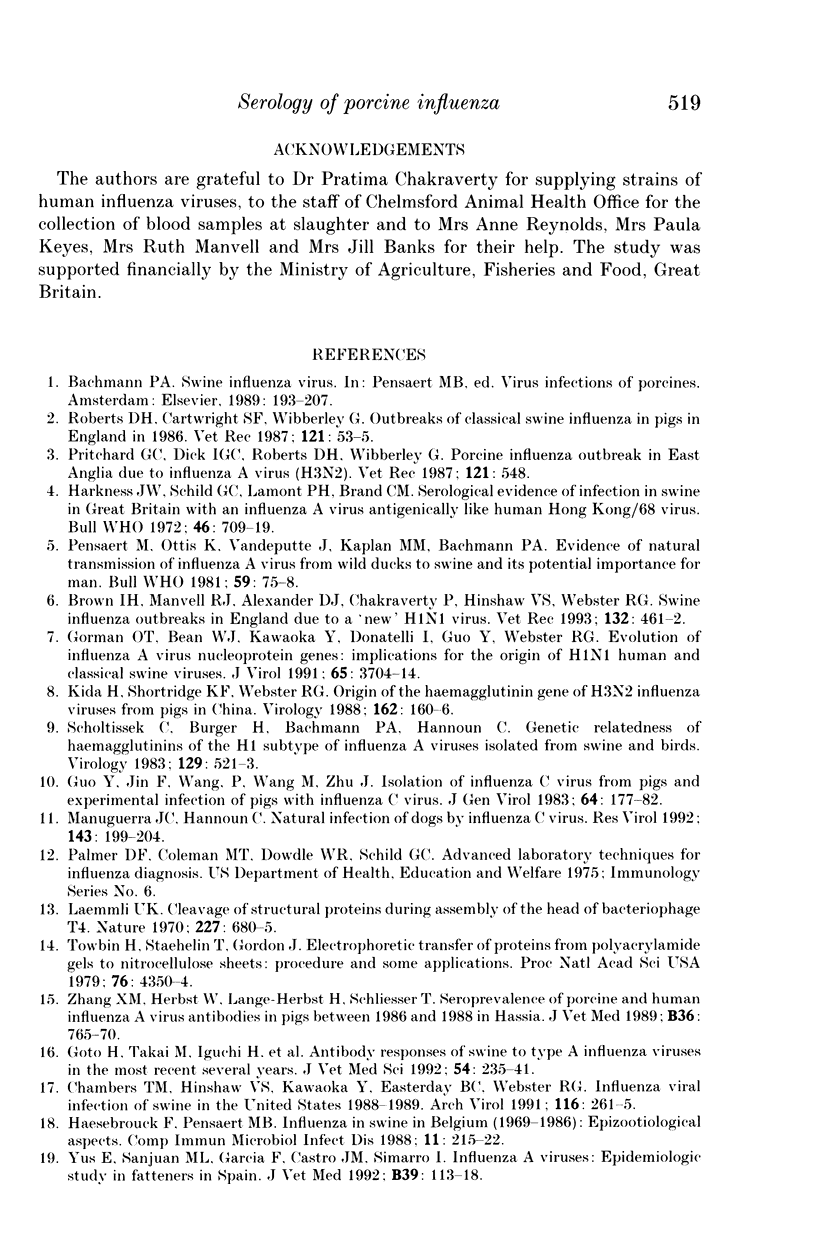
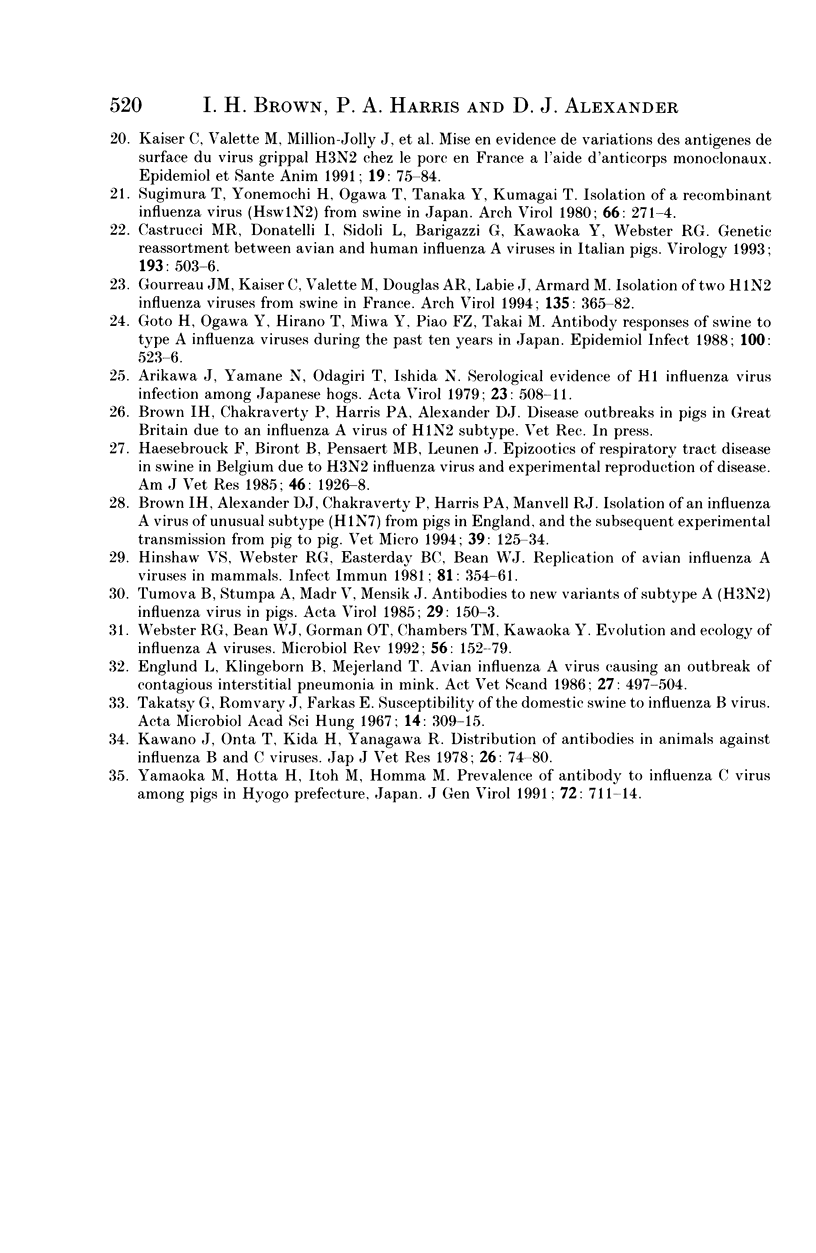
Selected References
These references are in PubMed. This may not be the complete list of references from this article.
- Arikawa J., Yamane N., Odagiri T., Ishida N. Serological evidence of H1 influenza virus infection among Japanese hogs. Acta Virol. 1979 Nov;23(6):508–511. [PubMed] [Google Scholar]
- Brown I. H., Alexander D. J., Chakraverty P., Harris P. A., Manvell R. J. Isolation of an influenza A virus of unusual subtype (H1N7) from pigs in England, and the subsequent experimental transmission from pig to pig. Vet Microbiol. 1994 Mar;39(1-2):125–134. doi: 10.1016/0378-1135(94)90093-0. [DOI] [PubMed] [Google Scholar]
- Brown I. H., Manvell R. J., Alexander D. J., Chakraverty P., Hinshaw V. S., Webster R. G. Swine influenza outbreaks in England due to a new H1N1 virus. Vet Rec. 1993 May 1;132(18):461–462. doi: 10.1136/vr.132.18.461. [DOI] [PubMed] [Google Scholar]
- Castrucci M. R., Donatelli I., Sidoli L., Barigazzi G., Kawaoka Y., Webster R. G. Genetic reassortment between avian and human influenza A viruses in Italian pigs. Virology. 1993 Mar;193(1):503–506. doi: 10.1006/viro.1993.1155. [DOI] [PubMed] [Google Scholar]
- Chambers T. M., Hinshaw V. S., Kawaoka Y., Easterday B. C., Webster R. G. Influenza viral infection of swine in the United States 1988-1989. Arch Virol. 1991;116(1-4):261–265. doi: 10.1007/BF01319247. [DOI] [PubMed] [Google Scholar]
- Englund L., Klingeborn B., Mejerland T. Avian influenza A virus causing an outbreak of contagious interstitial pneumonia in mink. Acta Vet Scand. 1986;27(4):497–504. doi: 10.1186/BF03548129. [DOI] [PMC free article] [PubMed] [Google Scholar]
- Gorman O. T., Bean W. J., Kawaoka Y., Donatelli I., Guo Y. J., Webster R. G. Evolution of influenza A virus nucleoprotein genes: implications for the origins of H1N1 human and classical swine viruses. J Virol. 1991 Jul;65(7):3704–3714. doi: 10.1128/jvi.65.7.3704-3714.1991. [DOI] [PMC free article] [PubMed] [Google Scholar]
- Goto H., Ogawa Y., Hirano T., Miwa Y., Piao F. Z., Takai M., Noro S., Sakurada N. Antibody responses of swine to type A influenza viruses during the past ten years in Japan. Epidemiol Infect. 1988 Jun;100(3):523–526. doi: 10.1017/s095026880006725x. [DOI] [PMC free article] [PubMed] [Google Scholar]
- Goto H., Takai M., Iguchi H., Benkele W., Ohta C., Yamamoto Y., Kida H., Noro S., Sakurada N. Antibody responses of swine to type A influenza viruses in the most recent several years. J Vet Med Sci. 1992 Apr;54(2):235–241. doi: 10.1292/jvms.54.235. [DOI] [PubMed] [Google Scholar]
- Gourreau J. M., Kaiser C., Valette M., Douglas A. R., Labie J., Aymard M. Isolation of two H1N2 influenza viruses from swine in France. Arch Virol. 1994;135(3-4):365–382. doi: 10.1007/BF01310021. [DOI] [PubMed] [Google Scholar]
- Guo Y. J., Jin F. G., Wang P., Wang M., Zhu J. M. Isolation of influenza C virus from pigs and experimental infection of pigs with influenza C virus. J Gen Virol. 1983 Jan;64(Pt 1):177–182. doi: 10.1099/0022-1317-64-1-177. [DOI] [PubMed] [Google Scholar]
- Haesebrouck F., Biront P., Pensaert M. B., Leunen J. Epizootics of respiratory tract disease in swine in Belgium due to H3N2 influenza virus and experimental reproduction of disease. Am J Vet Res. 1985 Sep;46(9):1926–1928. [PubMed] [Google Scholar]
- Haesebrouck F., Pensaert M. Influenza in swine in Belgium (1969-1986): epizootiologic aspects. Comp Immunol Microbiol Infect Dis. 1988;11(3-4):215–222. doi: 10.1016/0147-9571(88)90040-9. [DOI] [PubMed] [Google Scholar]
- Harkness W., Schild G. C., Lamont P. H., Brand C. M. Studies on relationships between human and porcine influenza. 1. Serological evidence of infection in swine in Great Britain with an influenza A virus antigenically like human Hong Kong-68 virus. Bull World Health Organ. 1972;46(6):709–719. [PMC free article] [PubMed] [Google Scholar]
- Hinshaw V. S., Webster R. G., Easterday B. C., Bean W. J., Jr Replication of avian influenza A viruses in mammals. Infect Immun. 1981 Nov;34(2):354–361. doi: 10.1128/iai.34.2.354-361.1981. [DOI] [PMC free article] [PubMed] [Google Scholar]
- Kawano J., Onta T., Kida H., Yanagawa R. Distribution of antibodies in animals against influenza B and C viruses. Jpn J Vet Res. 1978 Oct;26(3-4):74–80. [PubMed] [Google Scholar]
- Kida H., Shortridge K. F., Webster R. G. Origin of the hemagglutinin gene of H3N2 influenza viruses from pigs in China. Virology. 1988 Jan;162(1):160–166. doi: 10.1016/0042-6822(88)90405-9. [DOI] [PubMed] [Google Scholar]
- Laemmli U. K. Cleavage of structural proteins during the assembly of the head of bacteriophage T4. Nature. 1970 Aug 15;227(5259):680–685. doi: 10.1038/227680a0. [DOI] [PubMed] [Google Scholar]
- Manuguerra J. C., Hannoun C. Natural infection of dogs by influenza C virus. Res Virol. 1992 May-Jun;143(3):199–204. doi: 10.1016/s0923-2516(06)80104-4. [DOI] [PubMed] [Google Scholar]
- Pensaert M., Ottis K., Vandeputte J., Kaplan M. M., Bachmann P. A. Evidence for the natural transmission of influenza A virus from wild ducts to swine and its potential importance for man. Bull World Health Organ. 1981;59(1):75–78. [PMC free article] [PubMed] [Google Scholar]
- Pritchard G. C., Dick I. G., Roberts D. H., Wibberley G. Porcine influenza outbreak in East Anglia due to influenza A virus (H3N2) Vet Rec. 1987 Dec 5;121(23):548–548. [PubMed] [Google Scholar]
- Roberts D. H., Cartwright S. F., Wibberley G. Outbreaks of classical swine influenza in pigs in England in 1986. Vet Rec. 1987 Jul 18;121(3):53–55. doi: 10.1136/vr.121.3.53. [DOI] [PubMed] [Google Scholar]
- Scholtissek C., Bürger H., Bachmann P. A., Hannoun C. Genetic relatedness of hemagglutinins of the H1 subtype of influenza A viruses isolated from swine and birds. Virology. 1983 Sep;129(2):521–523. doi: 10.1016/0042-6822(83)90194-0. [DOI] [PubMed] [Google Scholar]
- Sugimura T., Yonemochi H., Ogawa T., Tanaka Y., Kumagai T. Isolation of a recombinant influenza virus (Hsw 1 N2) from swine in Japan. Arch Virol. 1980;66(3):271–274. doi: 10.1007/BF01314741. [DOI] [PubMed] [Google Scholar]
- Takátsy G., Romváry J., Farkas E. Susceptibility of the domestic swine to influenza B virus. Acta Microbiol Acad Sci Hung. 1967;14(3):309–315. [PubMed] [Google Scholar]
- Towbin H., Staehelin T., Gordon J. Electrophoretic transfer of proteins from polyacrylamide gels to nitrocellulose sheets: procedure and some applications. Proc Natl Acad Sci U S A. 1979 Sep;76(9):4350–4354. doi: 10.1073/pnas.76.9.4350. [DOI] [PMC free article] [PubMed] [Google Scholar]
- Tůmova B., Stumpa A., Mádr V., Mensík J. Antibodies to new variants of subtype A(H3 N2) influenza virus in pigs. Acta Virol. 1985 Mar;29(2):150–153. [PubMed] [Google Scholar]
- Webster R. G., Bean W. J., Gorman O. T., Chambers T. M., Kawaoka Y. Evolution and ecology of influenza A viruses. Microbiol Rev. 1992 Mar;56(1):152–179. doi: 10.1128/mr.56.1.152-179.1992. [DOI] [PMC free article] [PubMed] [Google Scholar]
- Yamaoka M., Hotta H., Itoh M., Homma M. Prevalence of antibody to influenza C virus among pigs in Hyogo Prefecture, Japan. J Gen Virol. 1991 Mar;72(Pt 3):711–714. doi: 10.1099/0022-1317-72-3-711. [DOI] [PubMed] [Google Scholar]
- Yus E., Sanjuan M. L., García F., Castro J. M., Simarro I. Influenza A viruses: epidemiologic study in fatteners in Spain (1987-89). Zentralbl Veterinarmed B. 1992 Mar;39(2):113–118. doi: 10.1111/j.1439-0450.1992.tb01145.x. [DOI] [PubMed] [Google Scholar]
- Zhang X. M., Herbst W., Lange-Herbst H., Schliesser T. Seroprevalence of porcine and human influenza A virus antibodies in pigs between 1986 and 1988 in Hassia. Zentralbl Veterinarmed B. 1989 Dec;36(10):765–770. doi: 10.1111/j.1439-0450.1989.tb00671.x. [DOI] [PubMed] [Google Scholar]


